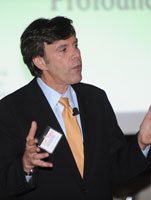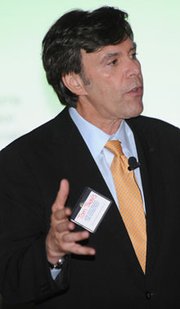Challenges Ahead for Manufacturers, Retailers in 2011
Economic growth in the United States will be taking baby steps for the next year as private companies slowly boost their payrolls.
One of the biggest drags to a rebound has been the stubbornly high unemployment rate, which stands at 9.6 percent across the country and at an even higher 12.4 percent in California. In the last two years, the U.S. economy has shed 9 million jobs, with 95,000 jobs being lost in September alone. Economists estimate it will take at least five to seven years for businesses to absorb enough people to reduce unemployment numbers to pre-recession levels.
“That is the biggest problem we have today, and that is the reason [the Federal Reserve] is so concerned,” said Wells Fargo Securities senior economist Eugenio Alemaacute;n.
He predicted the nation’s gross domestic product would inch up at a modest 1.5 percent to 1.7 percent for the next few quarters and that economic growth next year would be about the same as this year.
Alemaacute;n was speaking at the third annual “Economic Crystal Ball” seminar, organized by the California Fashion Association, in downtown Los Angeles on Oct. 14.
Hosted by Wells Fargo Capital Finance with presenting sponsor NGC Software, the event included a panel discussion featuring Stuart Brister, the chief executive officer and president of Wells Fargo Capital Finance; Mark Burstein, president of NGC Software; Michael Keenan, senior economic analyst for the Port of Los Angeles; and Rich Anderson, managing director of Moss Adams Capital LLC. Kevin Sullivan, executive vice president of Wells Fargo Capital Finance, served as moderator.
CFA members packed a large room inside the City Club to hear Alemaacute;n provide a glimpse of the economic future. He shared the podium with Tom Travis, a managing partner at Sandler, Travis & Rosenberg, a trade policy and customs law firm based in Miami.
Both speakers agreed that several challenges are in store for the apparel industry next year.
Travis noted that sourcing apparel is always fluctuating, dictated by new government officials and trade policies that vary from election to election. “When you are in the battle lines in sourcing, you have to look at what these governments say they are going to do and react,” Travis said, noting that the Obama administration wants China to revalue its artificially low currency, which makes Chinese imports cheap for U.S. consumers but makes U.S. exports more expensive for Chinese customers.Artificial growth
Alemaacute;n explained that the U.S. economy’s health has been fortified primarily by federal stimulus packages to keep consumers in the stores. He noted that fiscal packages such as cash for clunkers, $8,000 rebates for first-home buyers and withholding tax reductions have kept retail sales up. “We have grown during the last two years with the help of the Fed. I call this assisted growth,” the economist noted. “That assistance is winding down. ... This is one of the reasons the economy is slowing down. Normally, if things are okay, the private sector would take over and the economy would continue to grow. But the private economy is hiding. It is nowhere to be found.”
One of the biggest drags on growth has been the poor-performing housing market, which probably won’t be out of the dumps for at least another two to three years. The two strongest sectors that fueled expansion during the go-go period from 2004 to 2007 were residential construction and the real estate industry. “Those two sectors are not hiring and will not be hiring for many years to come,” Alemaacute;n said.
The Wells Fargo economist predicted that housing prices will remain the same for about two to three years and the Federal Reserve will keep interest rates low for the next 12 to 18 months. However, credit is starting to flow slowly again, but the economy will have a long slog in 2011. While economists still see deflation as a potential hazard, inflation could be the next big threat.Navigating international trade
Meanwhile, apparel manufacturers are facing some of the most trying times of their careers. Cotton prices are at an all-time high, up over $1 a pound; consumer spending is cautious; and sourcing in China is getting more difficult, with rising labor costs and uncertain delivery times.
While China still supplies about 40 percent of the apparel imported into the United States today, other countries are nibbling away at that country’s dominance, said Travis of Sandler, Travis & Rosenberg.
He noted that sourcing is governed by quotas, tariffs and trade preferences that make it more cost-effective for companies to manufacture in some countries more than others.
“Today, global sourcing is more than price, quality and delivery,” Travis said. “There are so many factors.”
One of those factors is free-trade agreements.
One free-trade pact that apparel makers should be watching is the Trans-Pacific Partnership, an agreement just beginning to take shape. So far, the accord would encompass the United States, Chile, Peru, Australia, Vietnam, Brunei, New Zealand and Singapore.
The Obama administration is pushing for free trade in these countries to create an East-West balance to China’s stronghold on manufacturing. “These negotiations are gearing up, and if you take a look at the numbers, it makes a lot of sense to your industry.” Travis said.
The third round of negotiations for the Trans-Pacific Partnership was held Oct. 5–8 in Brunei.
To show how government policies influence sourcing, Travis told the tale of the great underwear war of the 1990s. The war pitted Hanesbrands Inc., then the No. 2 apparel manufacturer in the United States, against Fruit of the Loom, which was No. 1.
For years, Hanes tried to overtake its archrival. But Fruit of the Loom was always able to deliver on lower prices.
Hanes started examining the trade policies put forth by the Reagan administration and saw that preferential treatment on quotas and tariffs was being given to Central American and Caribbean countries that used U.S. cotton in its locally made garments.
This preference was called the Caribbean Basin Economic Recovery Act. “Hanes took a look at this legislation and thought, ’We can move plants offshore while Fruit of the Loom continues doing production onshore,’” Travis said, adding that the decision reduced labor costs and resulted in Hanes becoming the best-selling underwear brand in the United States.
Fruit of the Loom ended up filing for Chapter 11 bankruptcy protection in 1999.
“Read the tea leaves,” Travis said. “Government makes a difference here.”

























